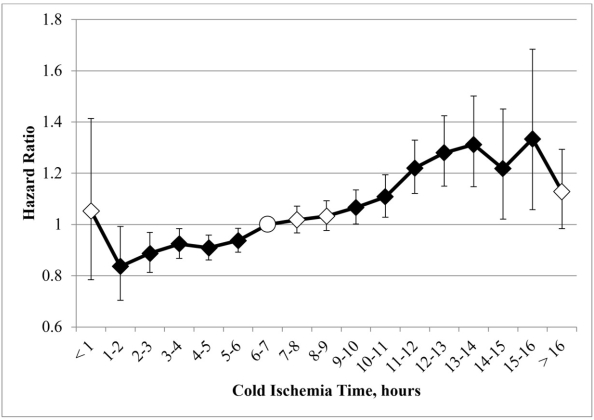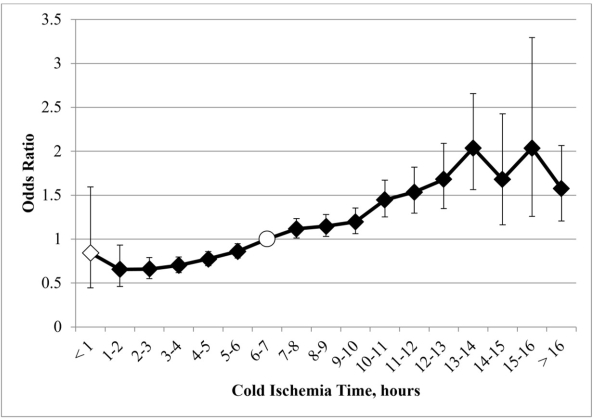Cold Ischemia Time is an Important Risk Factor for Post-Liver Transplant Prolonged Length of Stay
Michael E. DeBakey Department of Surgery, Division of Abdominal Transplantation, Baylor College of Medicine, Houston, TX.
Meeting: 2018 American Transplant Congress
Abstract number: A260
Keywords: Graft survival, Ischemia, Length of stay, Risk factors
Session Information
Session Name: Poster Session A: Liver: MELD, Allocation and Donor Issues (DCD/ECD)
Session Type: Poster Session
Date: Saturday, June 2, 2018
Session Time: 5:30pm-7:30pm
 Presentation Time: 5:30pm-7:30pm
Presentation Time: 5:30pm-7:30pm
Location: Hall 4EF
Background: Cold ischemia time (CIT) is often viewed as a categorical risk factor in liver transplantation. We hypothesize that the risk for adverse outcomes increases gradually with CIT and aim to conduct an hour-by-hour analysis of CIT and post-transplant outcomes, including graft loss and prolonged length of stay (PLOS).
Methods: We retrospectively reviewed all first adult liver transplants between March 2002 and September 2016 in the UNOS database. 67,426 recipients were categorized by hourly CIT increments. Multivariate time-to-event cox regression was performed for graft survival and multivariate logistic regression was performed for PLOS, defined as > 30 days.
Results: As demonstrated in Figure 1, CIT 1-6 hours were protective against graft loss (HR 0.84-0.94, p < 0.04), while CIT 9-16 hours demonstrated increased risk (HR 1.07-1.33, p < 0.04). CIT was consistently associated with PLOS, with an increase in risk for PLOS observed with increasing CIT (Figure 2). CIT 1-2 hours offered greatest protection against PLOS (OR 0.66, 95% CI 0.46-0.93), while CIT groups 13-14 (OR 2.04, 95% CI 1.56-2.66) and 15-16 hours posed the greatest risk (OR 2.04, 95% CI 1.26-3.29).
Conclusion: While graft survival is impacted by CIT, especially at the extremes, post-transplant PLOS is even more sensitive to CIT, with a substantial increase in risk observed with small increments of additional CIT. We conclude that CIT should be minimized to protect against the morbidity and cost associated with post-transplant PLOS.
Figure 1. CIT and Graft Survival
White circle: reference group; white diamond: p > 0.05; black diamond: p < 0.05
Figure 2. CIT and PLOS
White circle: reference group; white diamond: p > 0.05; black diamond: p < 0.05.
CITATION INFORMATION: Pan E., Yoeli D., Galvan N., Kueht M., Cotton R., O'Mahony C., Goss J., Rana A. Cold Ischemia Time is an Important Risk Factor for Post-Liver Transplant Prolonged Length of Stay Am J Transplant. 2017;17 (suppl 3).
To cite this abstract in AMA style:
Pan E, Yoeli D, Galvan N, Kueht M, Cotton R, O'Mahony C, Goss J, Rana A. Cold Ischemia Time is an Important Risk Factor for Post-Liver Transplant Prolonged Length of Stay [abstract]. https://atcmeetingabstracts.com/abstract/cold-ischemia-time-is-an-important-risk-factor-for-post-liver-transplant-prolonged-length-of-stay/. Accessed December 22, 2025.« Back to 2018 American Transplant Congress


